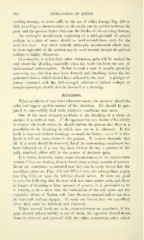Page 614 - My FlipBook
P. 614
612 EXTRACTION OF TEETH.
excising forceps, or better still, by the use of either forceps Fig. 488 or
489, according to circumstances, us the beaks can be carried between the
gum and the process better than can the blades of the excising forceps.
An antiseptic mouth-wash consisting of a tablespoonful of phenol
sodique to a glass of water should be used several times daily I'or the
next few days. Any other suitable antiseptic mouth-wash which may
be more agreeable to the patient may be used instead, though the jihcnol
sodique is highly efficacious.
Occasionally, in a few days after extraction, pain will be noticed in
and about the alveolus, especially when the tooth has been the seat of
pericemental inflammation. Relief in such a case is usually given by
removing any clot that may have formed, and breaking down the de-
generated tissues which should have adhered to the root. A pledget of
cotton saturated with the full-strength solution of phenol sodique or
camj)ho-phenique should then be inserted as a dressing.
Accidents.
When accidents of any kind whatever occur, the operator should be
calm and appear perfect master of the situation. He should be pre-
pared to successfully deal with whatever conditions may arise.
One of the most common accidents is the breaking of a whole or
portion of a tooth or root. If the operator has any doubt of his ability
to remove the tooth entire, he should inform the patient that there is a
possibility of its breaking, in which case not to be alarmed. If the
tooth is removed without breakage so much the better ; even if it does
break it will not cause alarm to the patient. It is more desirable that
all of a tooth should be removed, for if its surrounding membrane has
been inflamed, or if a root has been broken having a portion of the
pulp attached, either will be the source of obstinate pain.
It is better, however, under some circumstances, to let certain roots
remain if they are broken, than to break away a large amount of process.
Roots are sometimes so situated that they can be easily forced into the
maxillary sinus (see Figs. 516 and 517), or into the submaxillary region
(see Fig. 525), or upon the inferior dental nerve. If there are good
reasons for believing that the root will not cause undue pain, and there
is danger of breaking a large amount of process, it is preferable to let
it remain, as in a short time the contraction of the soft parts and the
expulsive efforts of Nature wuU force the root outward and it can then
be removed without danger. If roots are forced into the maxillary
sinus they must be followed and removed.
When several teeth are to be extracted under an anesthetic, if the
gum should adhere unduly to one of them, the operator should desist
from its removal and proceed with the other extractions, after which


